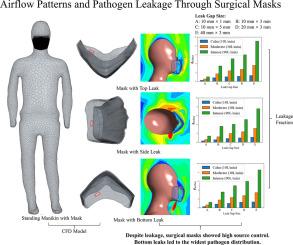The impact of leak gap size and position on surgical mask performance of source control: A numerical study
IF 7.1
1区 工程技术
Q1 CONSTRUCTION & BUILDING TECHNOLOGY
引用次数: 0
Abstract
Surgical masks are widely used for infectious source control by preventing infected individuals from transmitting pathogens. However, poor fit can create gaps between the mask and face, reducing their effectiveness. In this study, a numerical model was developed based on realistic surgical mask geometry with peripheral gaps of varying sizes and positions, fitted onto a breathing manikin. Exhalation leakage airflow dynamics and aerosol pathogen dispersion were investigated using a validated computational fluid dynamics (CFD) model with porous media. Results indicate that despite the presence of leaks, surgical masks are effective in controlling the spread of pathogens, with maximum airflow leakage at 9.11% and pathogen leakage at 16.83%. The average velocity of leaked airflow ranged from 0.12 m/s to 1.43 m/s, depending on the gap size and position. The position of the gap had little impact on the airflow and pathogen leakage fractions. Correlations between the average velocity of net leakage flow, leakage fractions of airflow and pathogens, and gap size were developed. Pathogens spread most widely from bottom leaks, followed by side and top leaks, with bottom leaks releasing up to 9.7 times more contaminated air than top leaks and 6.5 times more than side leaks. The findings also suggest that smaller gaps are associated with higher initial velocities of leakage, which in turn lead to wider dispersion of pathogens.

泄漏间隙大小和位置对源头控制手术面罩性能的影响:数值研究
外科口罩可防止受感染者传播病原体,被广泛用于传染源控制。然而,不佳的贴合度会在口罩和面部之间产生缝隙,从而降低其效果。在这项研究中,根据外科口罩的实际几何形状开发了一个数值模型,其外围缝隙的大小和位置各不相同,并将其安装在呼吸人体模型上。使用经过验证的多孔介质计算流体动力学(CFD)模型对呼气泄漏气流动力学和气溶胶病原体扩散进行了研究。结果表明,尽管存在泄漏,外科口罩仍能有效控制病原体的传播,最大气流泄漏率为 9.11%,病原体泄漏率为 16.83%。泄漏气流的平均速度从 0.12 米/秒到 1.43 米/秒不等,取决于缝隙的大小和位置。缝隙位置对气流和病原体泄漏率的影响很小。净泄漏流的平均速度、气流和病原体的泄漏率与间隙大小之间建立了相关关系。病原体从底部泄漏扩散得最广,其次是侧面和顶部泄漏,底部泄漏释放的污染空气是顶部泄漏的 9.7 倍,是侧面泄漏的 6.5 倍。研究结果还表明,间隙越小,泄漏的初始速度越高,从而导致病原体的扩散范围越广。
本文章由计算机程序翻译,如有差异,请以英文原文为准。
求助全文
约1分钟内获得全文
求助全文
来源期刊

Building and Environment
工程技术-工程:环境
CiteScore
12.50
自引率
23.00%
发文量
1130
审稿时长
27 days
期刊介绍:
Building and Environment, an international journal, is dedicated to publishing original research papers, comprehensive review articles, editorials, and short communications in the fields of building science, urban physics, and human interaction with the indoor and outdoor built environment. The journal emphasizes innovative technologies and knowledge verified through measurement and analysis. It covers environmental performance across various spatial scales, from cities and communities to buildings and systems, fostering collaborative, multi-disciplinary research with broader significance.
 求助内容:
求助内容: 应助结果提醒方式:
应助结果提醒方式:


